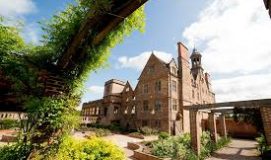The speaker at Blidworth and District Historical & Heritage Society’s March meeting was Pete Smith, who talked about the history and development of the gardens at Rufford Abbey.
Pete showed an old survey map of 1637, the earliest map of the site, explaining that originally there were no gardens as the abbey was a religious order that was confiscated with the dissolution of monasteries.
It later became part of the estate of the Earl of Shrewsbury — one of Bess of Hardwick’s husbands.
The Earl of Shrewsbury owned many houses, so Rufford was just a little used small hunting lodge unlikely to have had gardens.
The 5th and 6th Earls died without children and Dorothy Savile inherited Rufford. Her own home, Thornhill Hall, had been destroyed during the Civil War in 1626 and she moved to Rufford Abbey.
A new stable block and north wing were built by Sir George Savile (1633-1695) and the idea of formal gardens took seed! Three sets of gardens — Kings Garden, Fountain Garden and Parterre Garden — were created as a cross plan shows in drawings of 1680.
The gardens were dramatically changed time and time again as the use of the abbey went from a little-used hunting lodge to a family home, belonging to the influential Earl of Shrewsbury and his descendants.
Pete went on to explain how the gardens were developed, indicating where, in the current landscape, the ghosts of the gardens that are no longer there can still be seen.
The popular (for the times) “wilderness gardens” were laid out and later expanded — the area now known as the Broad Walk is a remnant of three runs radiating out to the A614. They did not last long as the maintenance of these maze-like avenues of manicured trees was labour intensive.
Plans for an amphitheatre and an exotic trellised summer house were shown, but no evidence can be found if or where they would have been built.
Sir George Savile, 7th Baronet (1678-1743) added the bath house and water gardens. Both required water and so several canals were constructed; the ghost outline of them can still be seen today, as can elements of the bathhouse as it was turned into a winter garden (1990s) and glazed over.
The lake was formed around 1750 and the Corn Mill was at the end of the lake. An interesting point is that most lakes found in England are manmade (with the exception of the Lake District and some Meres) and they all seemed to follow a design to include an island (or two) —Rufford has three!
In the 1960s, the lake was drained and a bridge that previously allowed access was found – intact.
It was the 8th Baronet, Sir George Savile, who spent time and money on the estate; he had new gates commissioned by James Foulgham in 1734. Slowly he changed the estate from a house and park to a house and gardens.
Forthcoming meetings
•April 7th, Bob Massey, on Nottinghamshire architect W.H.Higginbottom.
•May 5th, Laura Binns, on Nottingham Tram Works.
•June 2nd, Howard Heeley, on collecting aeroplanes.
The society’s members and guests are welcome to join meetings in the Function Room at Blidworth Welfare. Doors open at 6.45pm and there is ample parking.
New members are always welcome; just turn up on the night. There is a £2 charge on the door to cover refreshments.
The society’s book, ‘Blidworth and the First World War’, can be purchased from Blidworth Library or at Salon 68, Kirklington Road, Rainworth, or email [email protected]



 Posted on 11th Mar
Posted on 11th Mar


